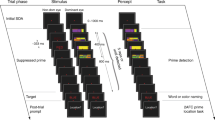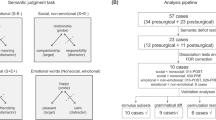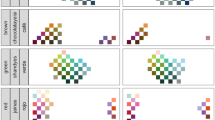Abstract
We report on two brain-damaged subjects who exhibit the uncommon pattern of loss of object color knowledge, but spared color perception and naming. The subject P.C.O., as in previously reported patients, is also impaired in processing other perceptual and functional properties of objects. I.O.C., in contrast, is the first subject on record to have impaired object color knowledge, but spared knowledge of object form, size and function. This pattern of performance is consistent with the view that semantic information about color and other perceptual properties of objects is grounded in modality-specific systems. Lesion analysis suggests that such grounding requires the integrity of the mesial temporal regions of the left hemisphere.
This is a preview of subscription content, access via your institution
Access options
Subscribe to this journal
Receive 12 print issues and online access
$209.00 per year
only $17.42 per issue
Buy this article
- Purchase on Springer Link
- Instant access to full article PDF
Prices may be subject to local taxes which are calculated during checkout


Similar content being viewed by others
References
Cavanagh, P. et al. Complete sparing of high-contrast color input to motion perception in cortical color blindness. Nat. Neurosci. 1, 242–247 (1998).
Heywood, C. A., Wilson, B. & Cowey, A. A case study of cortical colour “blindness” with relatively intact achromatic discrimination. J. Neurol. Neurosurg. Psychiatry 50, 22–29 (1987).
Meadows, J.C. Disturbed perception of colour associated with localized cerebral lesions. Brain 97, 615–632 (1974).
Zeki, S. A century of cerebral achromatopsia. Brain 113, 1721–1777 (1990).
Chao, L .I. & Martin, A. Cortical regions associated with perceiving, naming and knowing about colors. J. Cogn. Neurosci. 11, 25–35 (1999).
McKeefry, D. & Zeki, S. The position and topography of the human colour centre as revealed by functional magnetic resonance imaging. Brain 120, 2229–2242 (1997).
Zeki, S. & Marini, L. Three cortical stages of color processing in the human brain. Brain 121, 1669–1685 (1998).
Martin, A., Ungerleider, L. G. & Haxby, J. V. in The New Cognitive Neurosciences (ed. Gazzaniga, M.) 1023–1036 (MIT Press, Cambridge, Massachusetts, 2000).
Bartolomeo, P., Bachoud-Lévi, A.-C. & Denes, G. Preserved imagery for colours in a patient with cerebral achromatopsia. Cortex 33, 369–378 (1977).
Bartolomeo, P. et al. Multiple-domain dissociation between impaired visual perception and preserved visual imagery in a patient with bilateral extrastriate lesions. Neuropsychologia 36, 239–249 (1998).
Shuren, B. J., Brott, T. G., Schefft, B. K. & Houston, W. Preserved color imagery in an achromatopsic. Neuropsychologia 34, 485–489 (1996).
Zeki, S., Aglioti, S., McKeefry, D. & Berlucchi, G. The neurological basis of conscious color perception in a blind patient. Proc. Natl. Acad. Sci. USA 96, 14124–14129 (1999).
Cowey, A. & Heywood, C. A. There's more to colour than meets the eye. Behav. Brain Res. 71, 89–100 (1995).
Hadjikani, N., Liu, A. K., Dale, A. M., Cavanagh, P. & Tootell, R. B. H. Retinotopy and color sensitivity in human visual cortical area V8. Nat. Neurosci. 1, 235–241 (1998).
Davidoff, J. & Fodor, G. An annotated translation of Lewandowsky (1908) “Disconnection of the colour sense by focal disease of the brain.” Cognit. Neuropsychol. 6, 165–178 (1989).
Luzzatti, C. & Davidoff, J. Impaired retrieval of object-color knowledge with preserved color naming. Neuropsychologia 32, 933–950 (1994).
Farah, M. J., Levine, D. N. & Calvanio, R. A case study of mental imagery deficit. Brain Cogn. 8, 147–164 (1988).
Martin, A., Haxby, J. V., Lalonde, F. M., Wiggs, C. L. & Ungerleider, L. G. Discrete cortical regions associated with knowledge of color and knowledge of action. Science 270, 102–105 (1995).
Farnsworth, D. Farnsworth dichotomous test for colour-blindness. (Psychological Corporation, New York, 1947).
Ishihara, S. Tests for Colour-Blindness (Kanehara Shup, Tokyo, 1974).
Riddoch, M. J. & Humphreys, G. W. BORB (Birmingham Object Recognition Battery) (Lawrence Erlbaum Associates, Hove, UK, 1993).
Caramazza, A. & Shelton, J. R. Domain-specific knowledge systems in the brain: the animate-inanimate distinction. J. Cogn. Neurosci. 10, 1–34 (1998).
Vandenberghe, R., Price, C. J., Wise, R., Josephs, O. & Frackowiak, R. S. J. Semantic system(s) for words or pictures: functional anatomy. Nature 383, 254–256 (1996).
Allport, D. A. in Current Perspectives in Dysphasia (eds. Newman, S.K. & Epstein, R.) 207–244 (Churchill Livingstone, Edinburgh, 1985).
Warrington, E. K. & McCarthy, R. Categories of knowledge: further fractionations and an attempted integration. Brain 110, 1273–1296 (1987).
Caramazza, A. The interpretation of semantic category-specific deficits: what do they reveal about the organization of conceptual knowledge in the brain? Neurocase 4, 265–272 (1998).
Forde, E. M. E. & Humphreys, G. W. Category-specific recognition impairments: a review of important case studies and influential theories. Aphasiology 13, 169–193 (1999).
Humphreys, G. W. & Forde, E. M. E. Hierarchies, similarity and interactivity in object recognition: on the multiplicity of 'category-specific' deficits in neuropsychological populations. Brain Behav. Sci. (in press).
Laiacona, M., Barbarotto, R. & Capitani, E. Perceptual and associative knowledge in category specific impairment of semantic memory: a study of two cases. Cortex 29, 727–740 (1993).
Lambon Ralph, M. A., Howard, D., Nightingale, G. & Ellis, A. W. Are living and non-living category-specific deficits causally linked to impaired perceptual or associative knowledge? Evidence from a category-specific double dissociation. Neurocase 4, 311–338 (1998).
Moss, H. E., Tyler, L. K., Durrant-Peatfield, M. & Bunn, E. M. Two eyes of a see-through: impaired and intact semantic knowledge in a case of selective deficit for living things. Neurocase 4, 291–310 (1998).
Samson, D., Pillon, A. & De Wilde, V. Impaired knowledge of visual and non-visual attributes in a patient with a semantic impairment for living entities: a case of a true category-specific deficit. Neurocase 4, 273–290 (1998).
Coltheart, M. et al. A semantic subsystem specific to the storage of information about the visual attributes of animate and inanimate objects. Neurocase 4, 353–370 (1998).
Shelton, J. R., Fouch E. & Caramazza, A. The selective sparing of body part knowledge: a case study. Neurocase 4, 339–352 (1998).
Jackendoff, R. On beyond zebra: the relation of linguistic and visual information. Cognition 26, 89–114 (1987).
Miller, G. A. & Johnson-Laird, P. N. Language and Perception (Harvard Univ. Press, Cambridge, Massachusetts, 1976).
Economo, C. & Koskinas, G. N. Die cytoarchitektonik der hirnrinde des erwachsenen menschen (Springer, Wien, 1925).
Miceli, G., Laudanna, A., Burani, C. & Capasso, R. Batteria per l'analisi dei deficit afasici (CEPSAG, Roma, 1994).
Acknowledgements
This research was supported by NIH grant DC04245, and by a grant from MURST. We thank I.O.C., P.C.O. and S.L.A. for their participation in this study. We also thank P. Cavanagh, K. Link and K. Shapiro for their comments.
Author information
Authors and Affiliations
Corresponding author
Rights and permissions
About this article
Cite this article
Miceli, G., Fouch, E., Capasso, R. et al. The dissociation of color from form and function knowledge. Nat Neurosci 4, 662–667 (2001). https://doi.org/10.1038/88497
Received:
Accepted:
Issue Date:
DOI: https://doi.org/10.1038/88497
This article is cited by
-
Brain-inspired models for visual object recognition: an overview
Artificial Intelligence Review (2022)
-
Social and emotion dimensional organizations in the abstract semantic space: the neuropsychological evidence
Scientific Reports (2021)
-
Normal colour perception in developmental prosopagnosia
Scientific Reports (2021)
-
Color Vision Deficits
Current Neurology and Neuroscience Reports (2021)
-
Dimensional bias and adaptive adjustments in inhibitory control of monkeys
Animal Cognition (2021)



